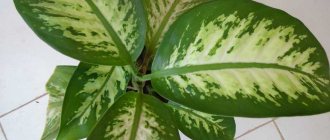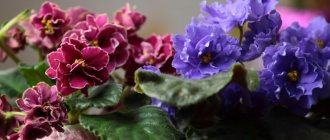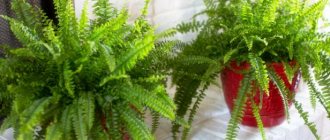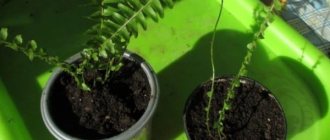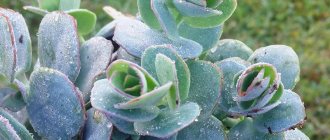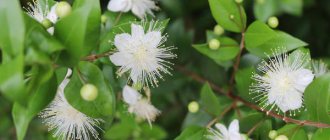- home
- Plant care
>
Azalea Roses Violets Lilies Anthurium Orchid Begonia Fuchsia Croton (codiaum) Palms Gerbera Coffee tree Lemon Cyclamen Aloe Decembrist Caring for potted plants Celosia Narcissus Saintpaulia Fittonia Plumeria Cissus Orange Strobilanthes Boxwood Neomarica
Indoor plants are amazing representatives of the flora. In response to care and careful attitude, they respond with beautiful flowering and delight with elastic green foliage. It doesn’t matter how they came to you: whether they were a gift or purchased, without proper care, houseplants will stop blooming and wither.
There are no trifles in caring for flowers in a pot:
- They are sensitive to room temperature, lighting, humidity and other conditions.
- It is important to water them on time, cut off dry leaves, feed them, and spray them.
The company's specialists urge: be responsible when leaving for a long time on trips or business trips. Even a week's absence of watering or spraying is a test for green “pets”.
We, as a company that has been working in the field of servicing indoor plants for many years, offer flower care services. If individuals or organizations entrust watering, replanting, and fertilizing to our specialists, they can be sure that the service will be provided at a high level.
Light
All plants live mainly only due to light. Its quantity is decisive in choosing pets. Indoors these are windows and artificial sources (all kinds of lamps).
Most flowers do best in window areas where there is sun during the afternoon, before or after lunch. With such illumination, 90% of the range of plants offered in flower shops can be easily grown. If you have a north window, then the choice of colors becomes a little smaller. If the direction of the window is south, you should carefully monitor your pets in the summer, shade them or move them a little further from the window to avoid sunburn.
If you really want to place the plant deep in the room, artificial lighting is used. It should work for 8-12 hours (there are sockets with a timer for this) during the day and be located at a distance of 30 cm to 1 m from the plant. It is best to use fluorescent lamps with a special “flora” spectrum. Spot, “ceiling” lamps provide less illumination and burn out faster. One fluorescent lamp may be enough to grow a group of 3-5 small plants or one, 1-1.2 m in size. You also need to take into account that not all plants develop well and do not lose their decorative appearance in artificial light.
Choosing Plants for Beginners
In order not to be disappointed in your hobby, you must first choose unpretentious flowers. If you prefer flowering specimens, then you should plant shade-loving plants. These are anthurium, spathiphyllum, clivia.
Among the unpretentious and non-flowering ones, it is best to choose fern, ficus, cyperus, chamedorea and others.
You can choose those that do not require regular watering: cacti, aloe, rebutia, spurge.
If time permits, it is better to start with flowering specimens, because they are better than others at raising your spirits. If you bought a flower in a store, when you bring it home, give it time to adapt, and then determine the location and replant.
Having chosen a flower, study the conditions in which it will be comfortable to grow. Read information about preferences for watering, humidity, lighting. Some plants can quickly adapt to a new environment, while others take time to adjust.
Don't try to water too much right away. Remember that not all flowers like to be filled with water. And be sure to observe the temperature regime, provide lighting and air humidity.
Caring for flowers while on vacation
So, before leaving on vacation, we seal all the windows. And, if it is summer, the air in the room is heated by the scorching sun. In winter, heating does the same. Therefore, the plants are positioned so that sunlight necessarily falls on them, the flowers are placed in a fairly dense group (the flowers create a more comfortable microclimate for themselves), while choosing the coolest possible place. Air humidity is maintained using the methods described above.
A few examples. Kitchen sink. Fill it to the brim with water and plug the hole. We group the plants side by side on a damp cloth mat, one end of which is lowered into a sink filled with water. Air humidity is ensured for several days. Or we place the flowers on the floor (the coolest air is below), and place bowls of water between them.
Separately, I would like to dwell on the methods of watering the soil.
For this you can use, for example, ceramic humidifiers. They are usually made in the form of funny figures, to the bottom of which is attached a small oblong reservoir for water made of unfired clay. The figurine is stuck into the ground with a reservoir of water and gradually releases moisture to the roots of the plant through the unburnt part.
It is also believed that soil moisture can be achieved using a container of water and a cord (such as twine). To do this, a wet cord is stuck into the soil of the plant in several places, the other end of which is placed in water. Thus, water constantly reaches the ground in small quantities.
There are more efficient and accurate irrigation systems. One of them works from the network. It turns on for a minute once a day and “pours” from 40 to 60 ml into the pot. At the same time, up to 36 plants can be watered through special distributors (supplied in the kit). Based on the number of flowers and water consumption per plant per day, as well as the number of days you will be absent, calculate the volume of water required for watering. Fill a container of suitable volume with water and immerse the mini-pump in it. Ready.
Tools
In order for crops to grow better, you should purchase various items to care for indoor plants:
It is important to use a watering can when watering. It is better to choose products equipped with a long spout. The procedure in this case is simple and convenient. In this case, the spout will penetrate through dense foliage faster.
To ensure that the plant receives a sufficient amount of moisture when the owners are away for a long time, you should take a flask. It's easy to use. To do this, pour water inside and stick the tip down into the ground. The earth will absorb a sufficient amount of moisture under such conditions.
To spray the leaves, you should buy a spray bottle. It is especially useful to use it in hot and dry weather. Otherwise, the leaf plates will dry out and the plant will lose its beautiful and well-groomed appearance.
The use of a tray with water is shown. This is especially useful in dry conditions of the culture. The pot is placed directly on the tray. In this case, the plant receives all the necessary substances and moisture through the root system.
Small rakes, spatulas and other tools that cannot be avoided when caring for indoor plants can also be used.
Tips for choosing colors
The range of colors offered on the market is very large. Don’t let this bother you, because the plants themselves “tell” in what conditions they want to live.
A wide leaf means that the body has adapted to compensate for the lack of light with a large area, i.e. does not tolerate direct light in summer and can be located on north-facing windows and grow in artificial light (monstera).
If the plant has a narrow leaf, it has adapted to transmit a large amount of sunlight through the crown. Those. is a light-loving plant that feels good only on eastern (western) windows, but not on the northern window and, as a rule, not under artificial light (myrtle).
Variegated varieties require more light than their green relatives - their leaves contain less green pigment chlorophyll.
Hard leathery leaves have plants that can tolerate low air humidity (ficus rubber), and, conversely, ferns (adiantum “Venus hair”) can die without additional spraying or a humidifier.
Plants with pubescent, velvety leaves (Saintpaulias, calatheas, begonias) prefer high (90% or higher) air humidity, but do not tolerate water on the leaves. In this case, the air around the plants is sprayed, creating “fog.”
Flowers that form thick trunks (cacti and their prickly counterparts, bottle plants) have a certain supply of moisture inside them, so they do not tolerate overwatering, and often in winter their soil is kept almost dry (jatropha, adenium obese, pachypodium).
As a rule, plants that have a lignified trunk and are capable of flowering and bearing fruit (ficus carica - figs, bougainvillea, citrus fruits) require a cool winter. Flowers with a green stem (Dieffenbachia) feel good at temperatures of +23-25 degrees Celsius all year round.
Most bulbous plants go dormant (shed their leaves completely) when they need a cool, dark place. They are exposed to the light as soon as the leaves or buds (hippeastrum) begin to hatch.
Basic rules of care
Having wide window sills and a sunny balcony, you can grow light-loving plants: begonia, geranium, lily. But in fact, there are many plants that do not like bright sun. They can be installed opposite the window, on a shelf, on a table (fern, dieffenbachia).
Azalea, asparagus, and anthurium feel great in a lack of light.
Watering
It is recommended to water indoor flowers according to their needs, which are not the same at different times of the year:
- In the spring, indoor flowers need frequent and abundant watering, because they have woken up from winter dormancy and begin to grow.
- In summer, watering should be reduced, making it more moderate. But in hot weather it needs to be increased again.
- In the autumn, pets are preparing for winter dormancy, so the amount of watering must be reduced.
- In winter, many flowers generally go into rest, so they need water. They will wake up only in the spring.
Feeding and replanting
During growth, flowers draw all useful substances from the ground, so they need fertilizing with fertilizers. For each type of flower, its own fertilizers are selected.
If a flower grows in one pot for more than 3 years, then it needs to be transplanted into nutrient soil. In addition to replanting, it is recommended to cut off shoots that are too long, which take away nutrients, leaving the entire plant without nutrition.
In summer, make sure your pets are not attacked by pests. The withered appearance of the flower will remind you of diseases and pests. Move it to another place, away from all the inhabitants of the green corner, then examine the flower.
First, remove all leaves that have been destroyed by midges and other pests, then treat with preparations that are sold in specialized stores.
Green taboo
In the assortment of plants that can be purchased in flower shops, there are indeed flowers whose leaves contain substances that can cause skin irritation. Basically, these are representatives of the family. Euphorbiaceae (codium, spurge) and fam. Aroids (Dieffenbachia). If you wear gloves when working with the leaves of these plants (pruning, for example), you will never feel any harmful effect. On the other hand, if there are small children in the house, you need to keep an eye on them so that the beautiful, bright leaf is not tasted. Pets, as a rule, are very smart in this matter - they can “eat” all your dracaena, but they will not touch the Dieffenbachia, or at least they will not eat it.
Advice from professional flower growers
Experts recommend following instructions for caring for indoor plants to keep them beautiful and healthy:
- If the plants become dull, water them with banana peel infusion. To do this, peel 2-3 bananas and fill the peels with warm water. You can water the infusion after a 2-3 day period.
- In dry and hot weather, spray the foliage with settled water from a spray bottle. In this case, the plant will maintain a beautiful and healthy appearance.
- Regularly use mineral compounds and organic matter as fertilizer. In this case, strictly follow the instructions written on the packaging.
- Water for irrigation must be settled. You can’t water it with boiled water. It lacks the necessary nutrients.
- If you find traces of dangerous insects, treat the plant with a soap solution.
- Prune crops regularly, removing diseased and old stems.
If you follow the rules of care, indoor plants will delight you with abundant flowering for a long time. It is enough just to water them in a timely manner and treat them from insect pests and dangerous diseases.
Express diagnostics
Attentive attitude towards your charges is a good component of their health. Regularly inspect the leaves of plants from the outside and inside, evaluate the appearance of the plant. But it is better to take any action only after consulting with a specialist. The main rule of doctors is to do no harm! First, find out the cause of your flower’s “disease,” and only then begin treatment. As a rule, it is enough to slightly change the plant’s maintenance regime (water less often, remove it from the scorching sun, feed it) and your pet’s health will improve.
Spraying for luscious leaf color
Everyone wants potted plants with bright green leaves on the windowsill. But standard care may not be enough for this. Grandmother’s advice is to add camphor alcohol to the spraying solution. For preparation you will need settled or rain water and a small amount of camphor alcohol. The components are mixed in a ratio of 3-4 drops of alcohol per 1 liter of liquid. The resulting solution is regularly sprayed onto the plants.
It is also important to pay attention to the temperature of the water. You should fill the irrigation container with warm or even slightly hot water, since it cools very quickly when sprayed. If you spray the leaves with cold water, this can lead to hypothermia, which many types of plants tolerate very poorly. The pot should not be in direct sunlight while spraying, as this can lead to burns.
Watering time
You can often hear advice from grandmothers that it is important to find the right time to water flowers. Indeed, it differs at different times of the year. So, in summer and spring, the most suitable time for watering is the evening, but in winter and autumn it is better to do it in the morning.
This is because after water gets in, the temperature in the soil drops noticeably, which slows down the activity of the root system. Such changes lead to a slowdown in fluid absorption processes. In connection with this, in the summer, watering is organized when the overall air temperature decreases, and in winter, on the contrary, it increases.
Land for transplantation
The condition of the soil significantly affects the appearance of home flowers. It must be taken into account that different types of plants require different soil characteristics. The main rule that must be followed: when transplanting flowering plants, the soil must be thoroughly compacted to reduce its air permeability, and for green species, on the contrary, it must be loosened.
In addition, you should pay attention to the composition of the soil, the level of acidity, and the amount of nutritional components. Only by taking into account all the requirements relating to a certain type of plant can you get a good result. For example, to grow cacti you need to choose sandy soil through which water quickly penetrates, but petunia will grow only in soil with a lot of nutrients.

